ITC571 Emerging Technologies: Storage for Computation Research
VerifiedAdded on 2023/06/03
|16
|1390
|469
Presentation
AI Summary
This presentation provides an overview of trading storage for computation, an emerging technology where storage space is utilized to increase the efficiency of numerical calculations. It reviews literature on the integration of cloud computing with storage tradeoff systems, highlighting benefits such as cost reduction and improved computing efficiency. The presentation also discusses the limitations and risks associated with cloud computing, particularly concerning external threats like cyber attacks. Key findings emphasize the effectiveness of combining storage trading with cloud computing in operational sectors that handle vast amounts of data. The reflection underscores the popularity of this technology in environments requiring extensive data computation, where recomputation replaces data storage for future retrieval. The presentation concludes with references to relevant research articles in APA format.
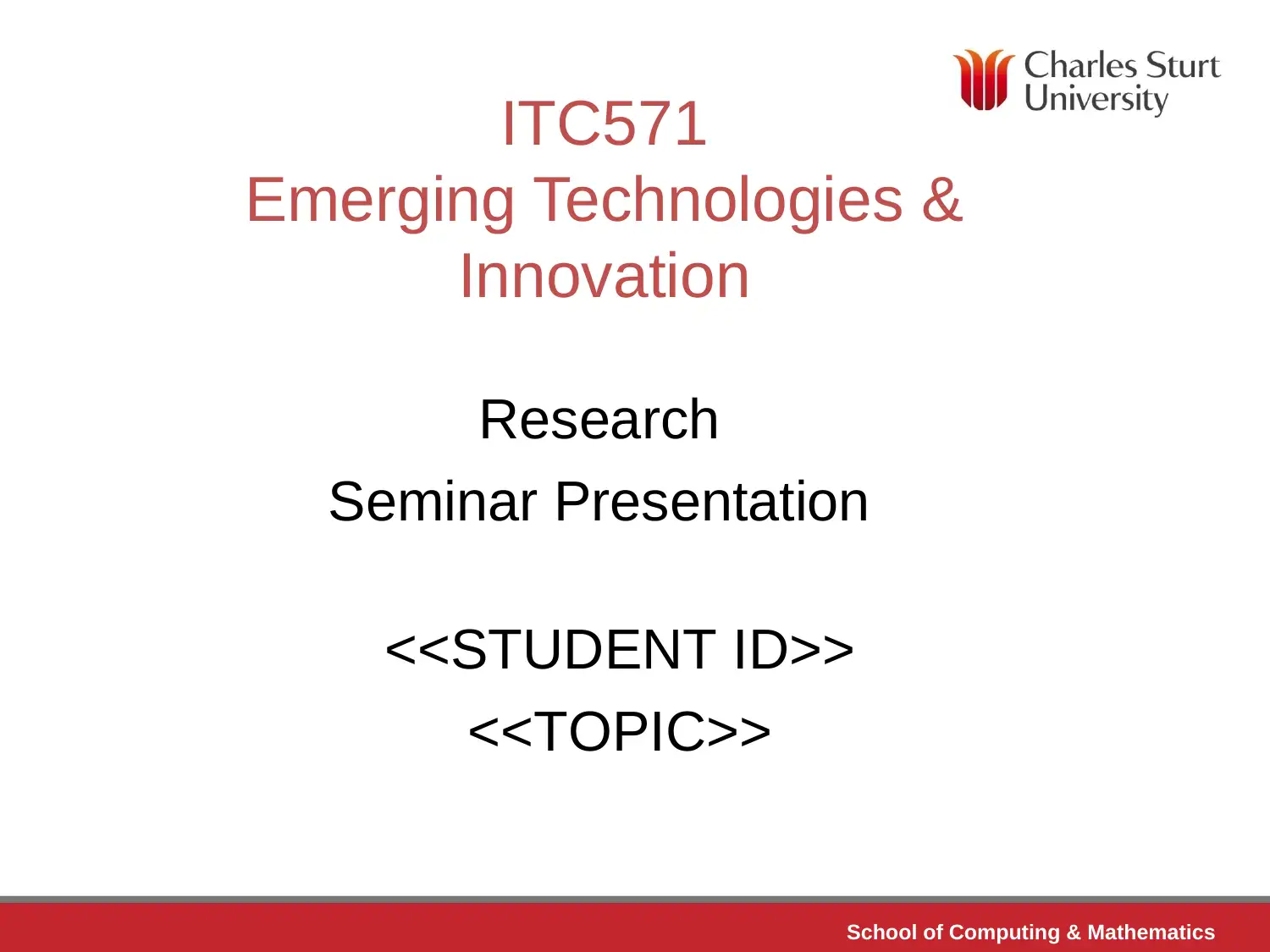
School of Computing & Mathematics
ITC571
Emerging Technologies &
Innovation
Research
Seminar Presentation
<<STUDENT ID>>
<<TOPIC>>
ITC571
Emerging Technologies &
Innovation
Research
Seminar Presentation
<<STUDENT ID>>
<<TOPIC>>
Paraphrase This Document
Need a fresh take? Get an instant paraphrase of this document with our AI Paraphraser
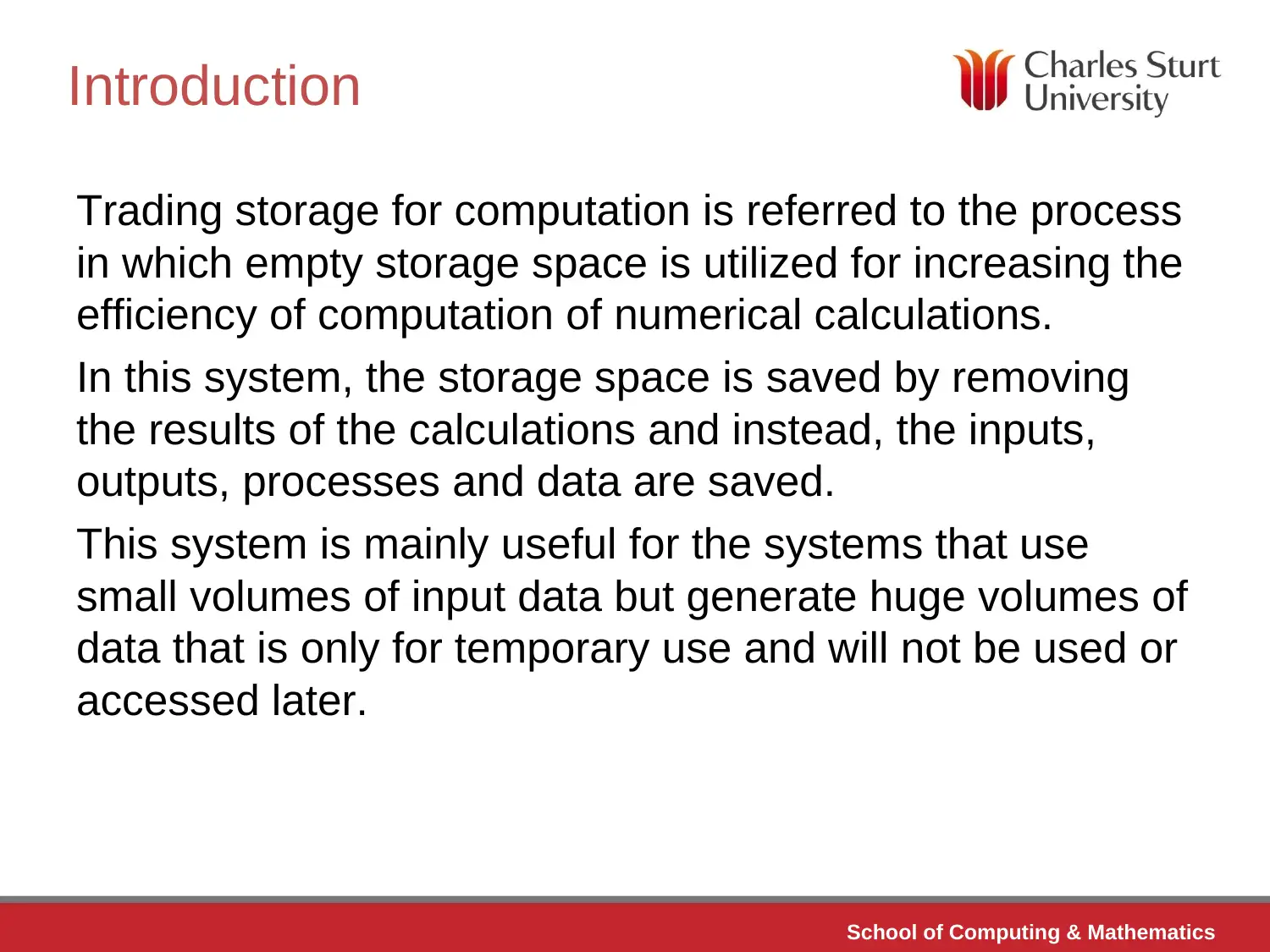
School of Computing & Mathematics
Introduction
Trading storage for computation is referred to the process
in which empty storage space is utilized for increasing the
efficiency of computation of numerical calculations.
In this system, the storage space is saved by removing
the results of the calculations and instead, the inputs,
outputs, processes and data are saved.
This system is mainly useful for the systems that use
small volumes of input data but generate huge volumes of
data that is only for temporary use and will not be used or
accessed later.
Introduction
Trading storage for computation is referred to the process
in which empty storage space is utilized for increasing the
efficiency of computation of numerical calculations.
In this system, the storage space is saved by removing
the results of the calculations and instead, the inputs,
outputs, processes and data are saved.
This system is mainly useful for the systems that use
small volumes of input data but generate huge volumes of
data that is only for temporary use and will not be used or
accessed later.
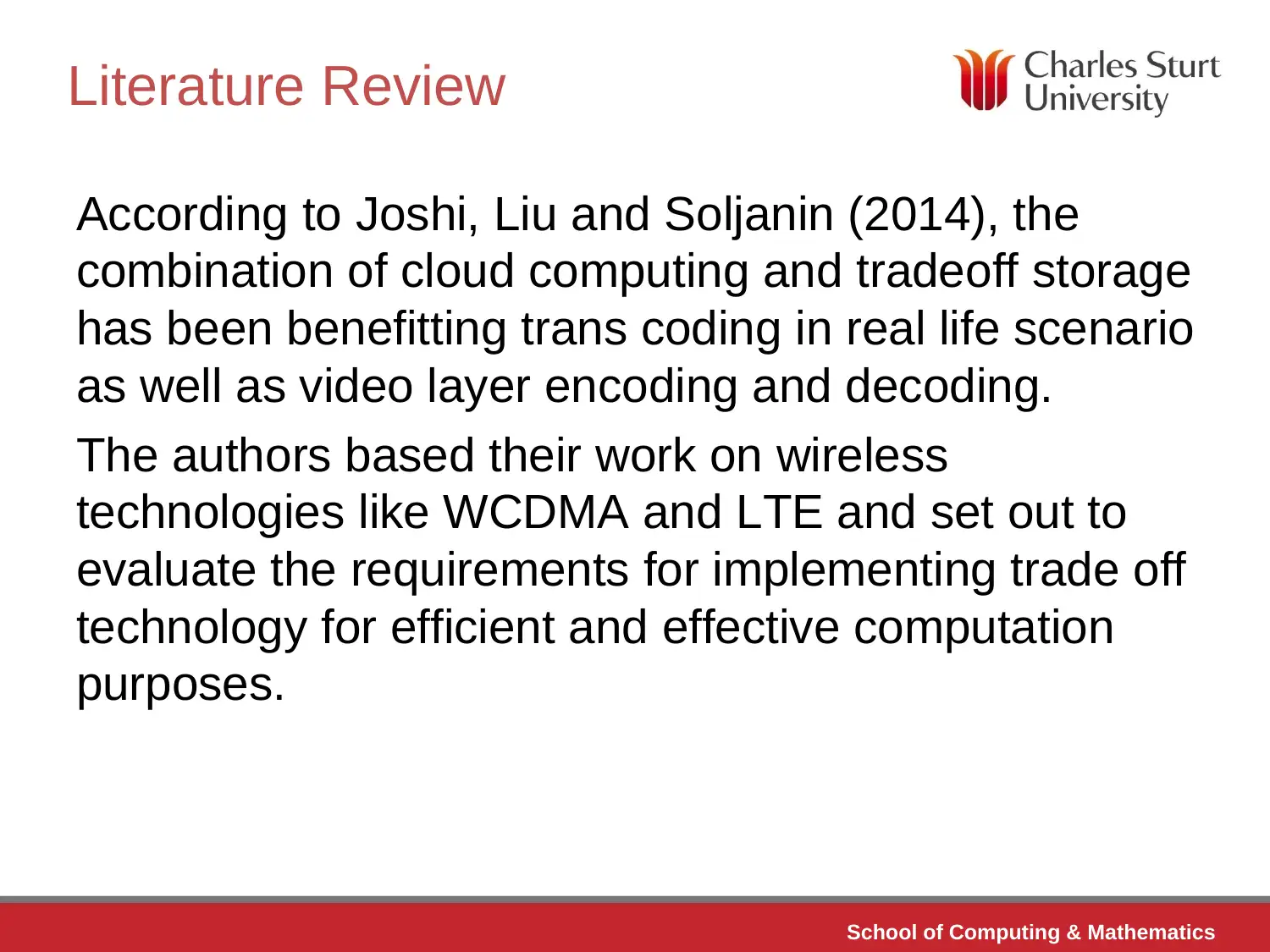
School of Computing & Mathematics
Literature Review
According to Joshi, Liu and Soljanin (2014), the
combination of cloud computing and tradeoff storage
has been benefitting trans coding in real life scenario
as well as video layer encoding and decoding.
The authors based their work on wireless
technologies like WCDMA and LTE and set out to
evaluate the requirements for implementing trade off
technology for efficient and effective computation
purposes.
Literature Review
According to Joshi, Liu and Soljanin (2014), the
combination of cloud computing and tradeoff storage
has been benefitting trans coding in real life scenario
as well as video layer encoding and decoding.
The authors based their work on wireless
technologies like WCDMA and LTE and set out to
evaluate the requirements for implementing trade off
technology for efficient and effective computation
purposes.
⊘ This is a preview!⊘
Do you want full access?
Subscribe today to unlock all pages.

Trusted by 1+ million students worldwide
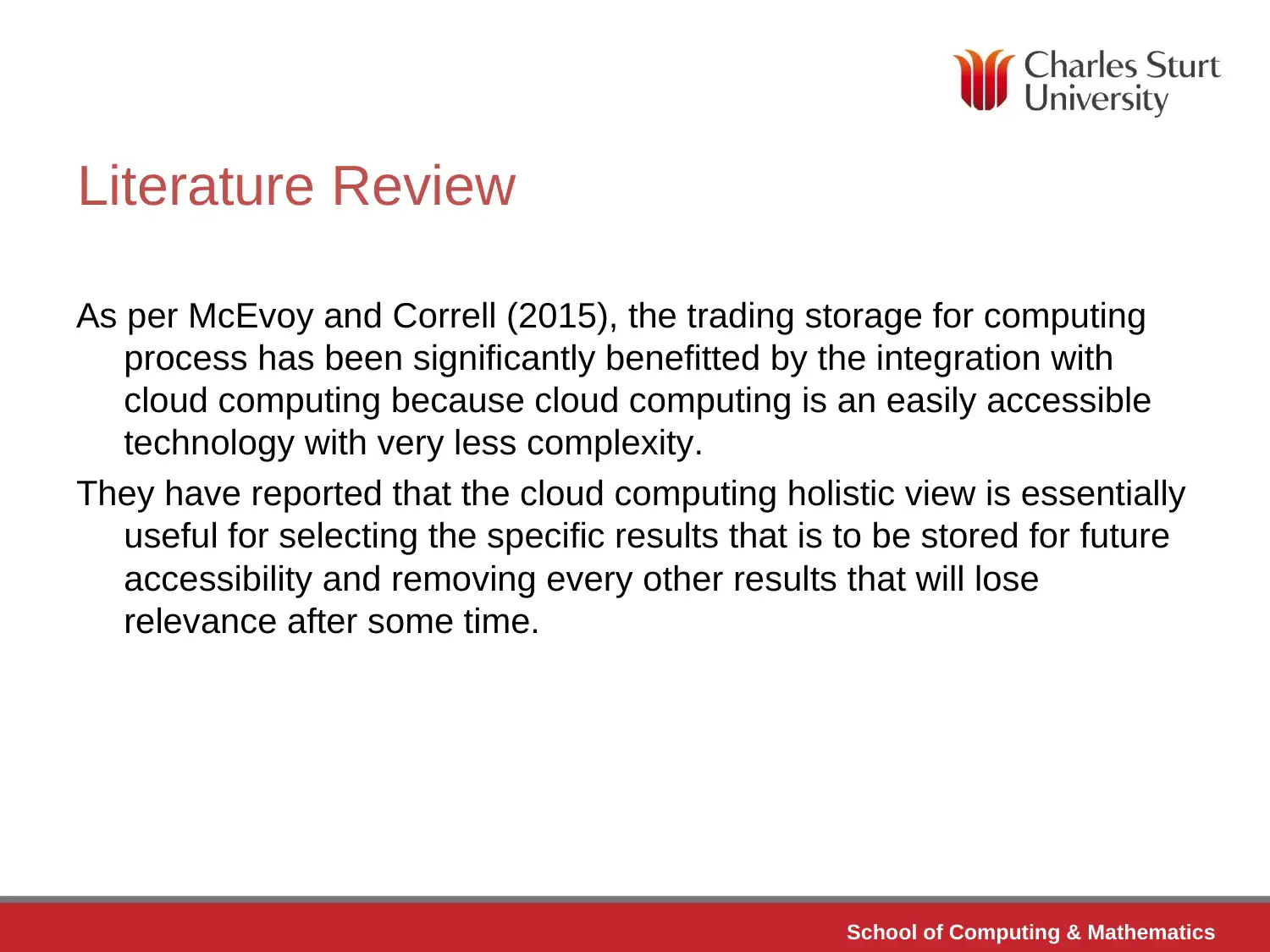
School of Computing & Mathematics
Literature Review
As per McEvoy and Correll (2015), the trading storage for computing
process has been significantly benefitted by the integration with
cloud computing because cloud computing is an easily accessible
technology with very less complexity.
They have reported that the cloud computing holistic view is essentially
useful for selecting the specific results that is to be stored for future
accessibility and removing every other results that will lose
relevance after some time.
Literature Review
As per McEvoy and Correll (2015), the trading storage for computing
process has been significantly benefitted by the integration with
cloud computing because cloud computing is an easily accessible
technology with very less complexity.
They have reported that the cloud computing holistic view is essentially
useful for selecting the specific results that is to be stored for future
accessibility and removing every other results that will lose
relevance after some time.
Paraphrase This Document
Need a fresh take? Get an instant paraphrase of this document with our AI Paraphraser
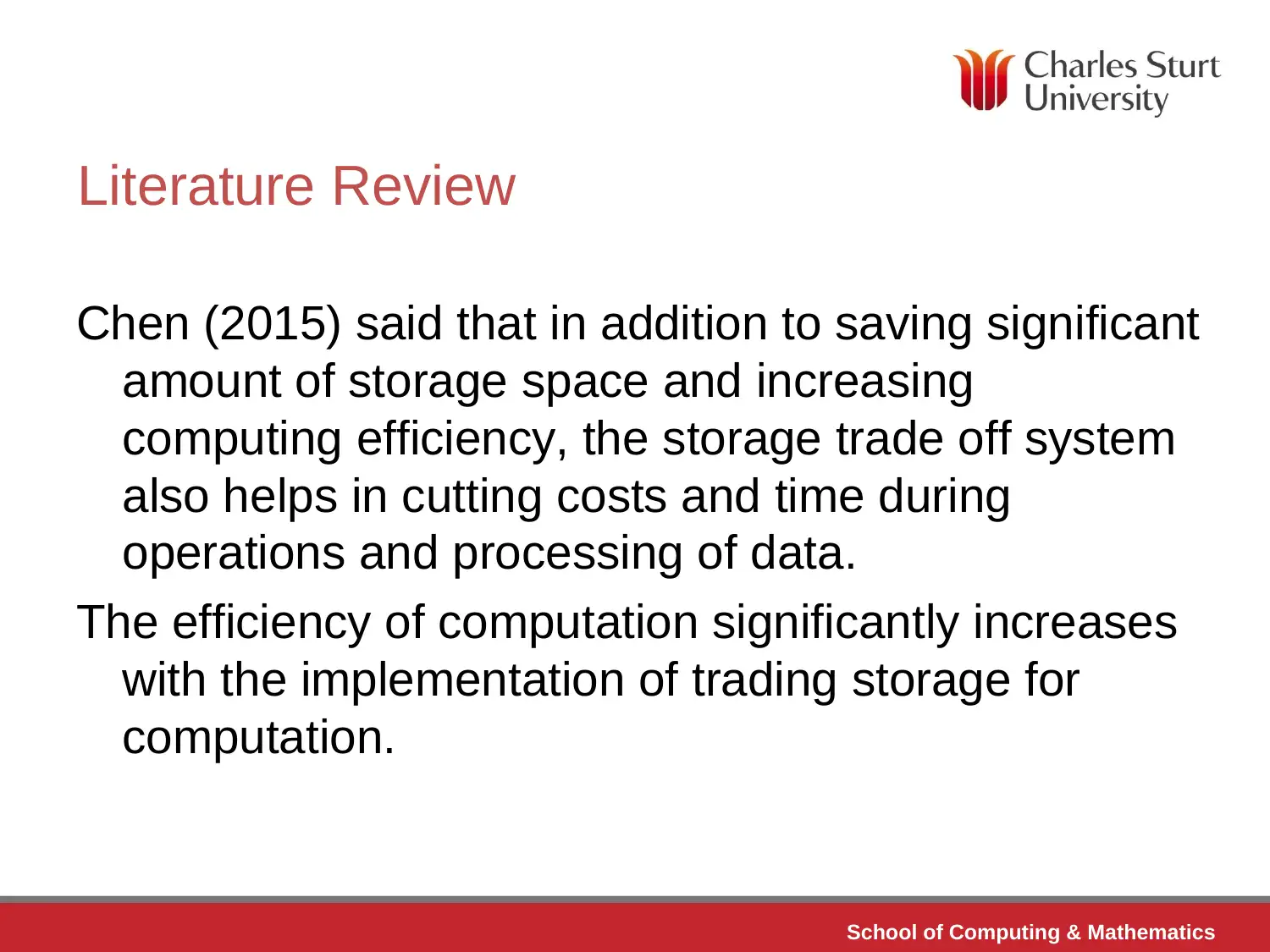
School of Computing & Mathematics
Literature Review
Chen (2015) said that in addition to saving significant
amount of storage space and increasing
computing efficiency, the storage trade off system
also helps in cutting costs and time during
operations and processing of data.
The efficiency of computation significantly increases
with the implementation of trading storage for
computation.
Literature Review
Chen (2015) said that in addition to saving significant
amount of storage space and increasing
computing efficiency, the storage trade off system
also helps in cutting costs and time during
operations and processing of data.
The efficiency of computation significantly increases
with the implementation of trading storage for
computation.
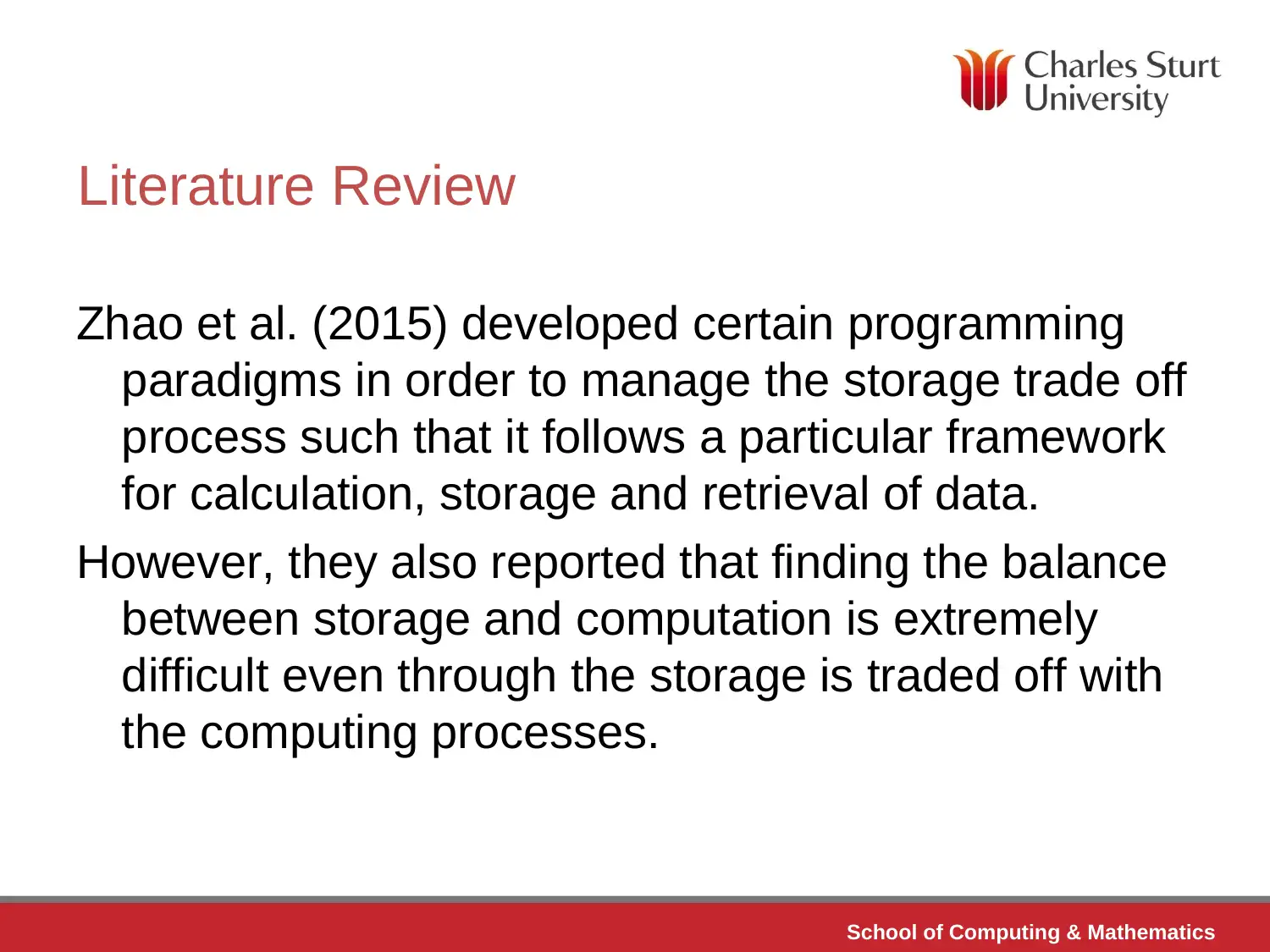
School of Computing & Mathematics
Literature Review
Zhao et al. (2015) developed certain programming
paradigms in order to manage the storage trade off
process such that it follows a particular framework
for calculation, storage and retrieval of data.
However, they also reported that finding the balance
between storage and computation is extremely
difficult even through the storage is traded off with
the computing processes.
Literature Review
Zhao et al. (2015) developed certain programming
paradigms in order to manage the storage trade off
process such that it follows a particular framework
for calculation, storage and retrieval of data.
However, they also reported that finding the balance
between storage and computation is extremely
difficult even through the storage is traded off with
the computing processes.
⊘ This is a preview!⊘
Do you want full access?
Subscribe today to unlock all pages.

Trusted by 1+ million students worldwide
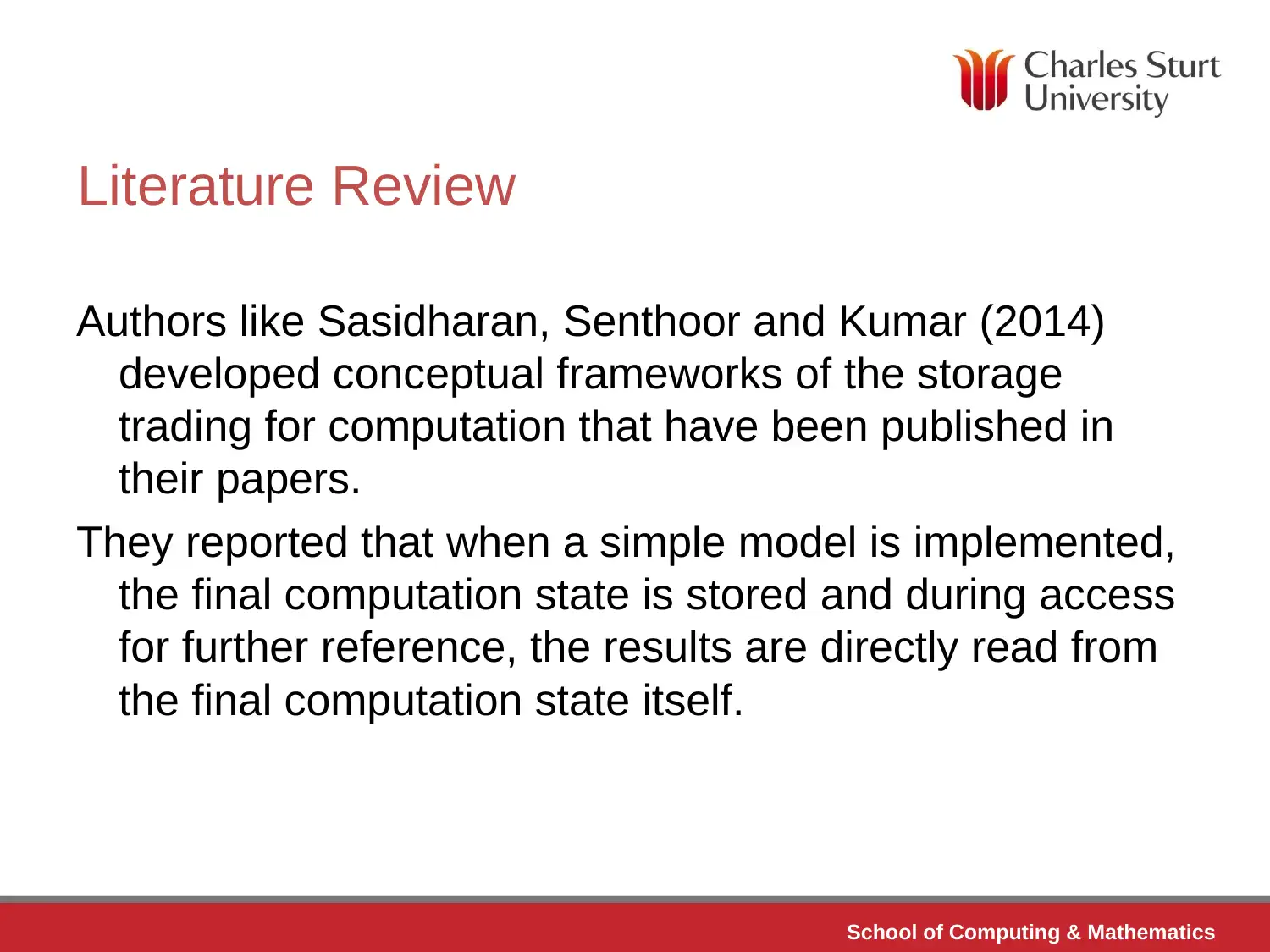
School of Computing & Mathematics
Literature Review
Authors like Sasidharan, Senthoor and Kumar (2014)
developed conceptual frameworks of the storage
trading for computation that have been published in
their papers.
They reported that when a simple model is implemented,
the final computation state is stored and during access
for further reference, the results are directly read from
the final computation state itself.
Literature Review
Authors like Sasidharan, Senthoor and Kumar (2014)
developed conceptual frameworks of the storage
trading for computation that have been published in
their papers.
They reported that when a simple model is implemented,
the final computation state is stored and during access
for further reference, the results are directly read from
the final computation state itself.
Paraphrase This Document
Need a fresh take? Get an instant paraphrase of this document with our AI Paraphraser
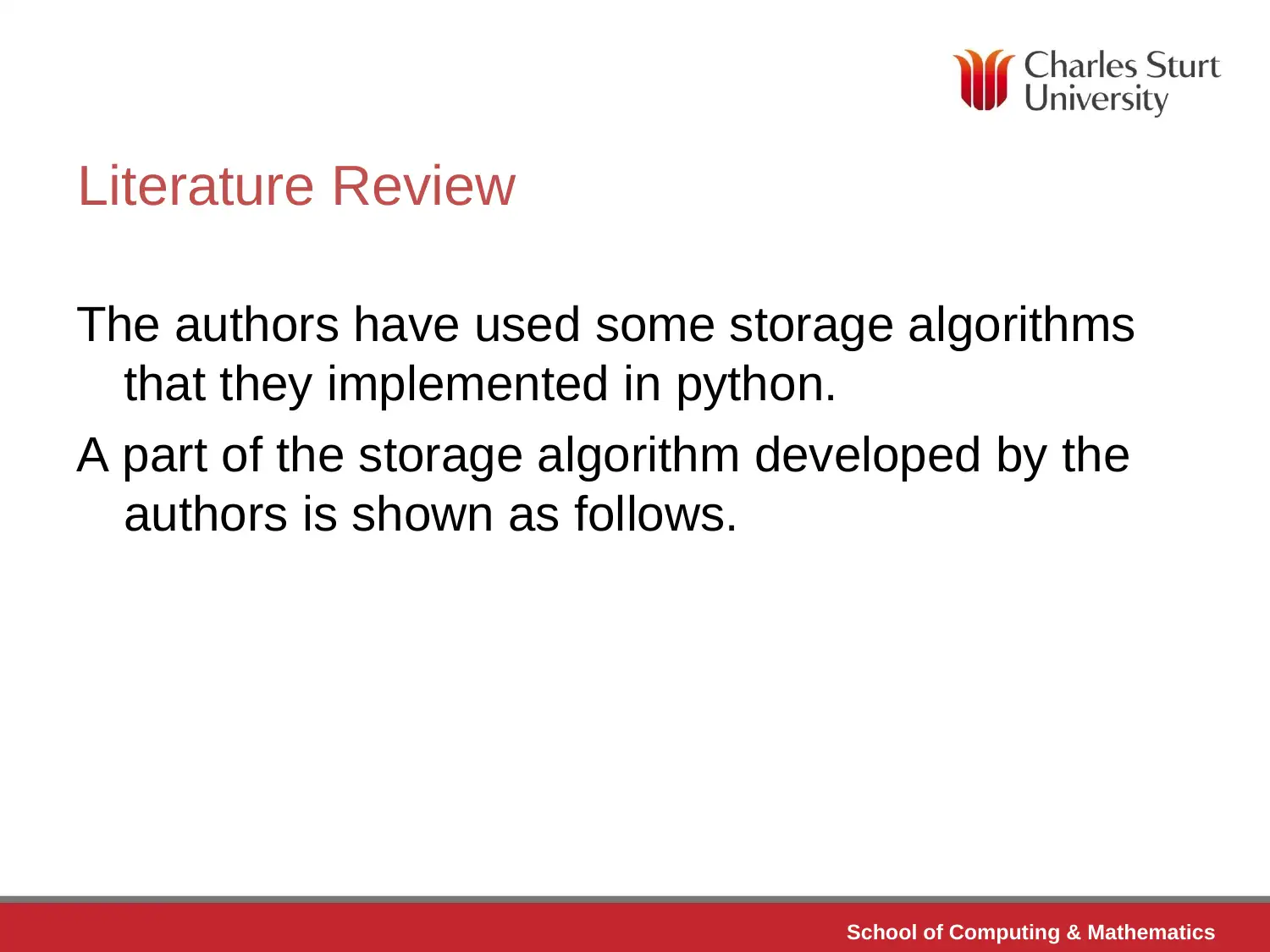
School of Computing & Mathematics
Literature Review
The authors have used some storage algorithms
that they implemented in python.
A part of the storage algorithm developed by the
authors is shown as follows.
Literature Review
The authors have used some storage algorithms
that they implemented in python.
A part of the storage algorithm developed by the
authors is shown as follows.
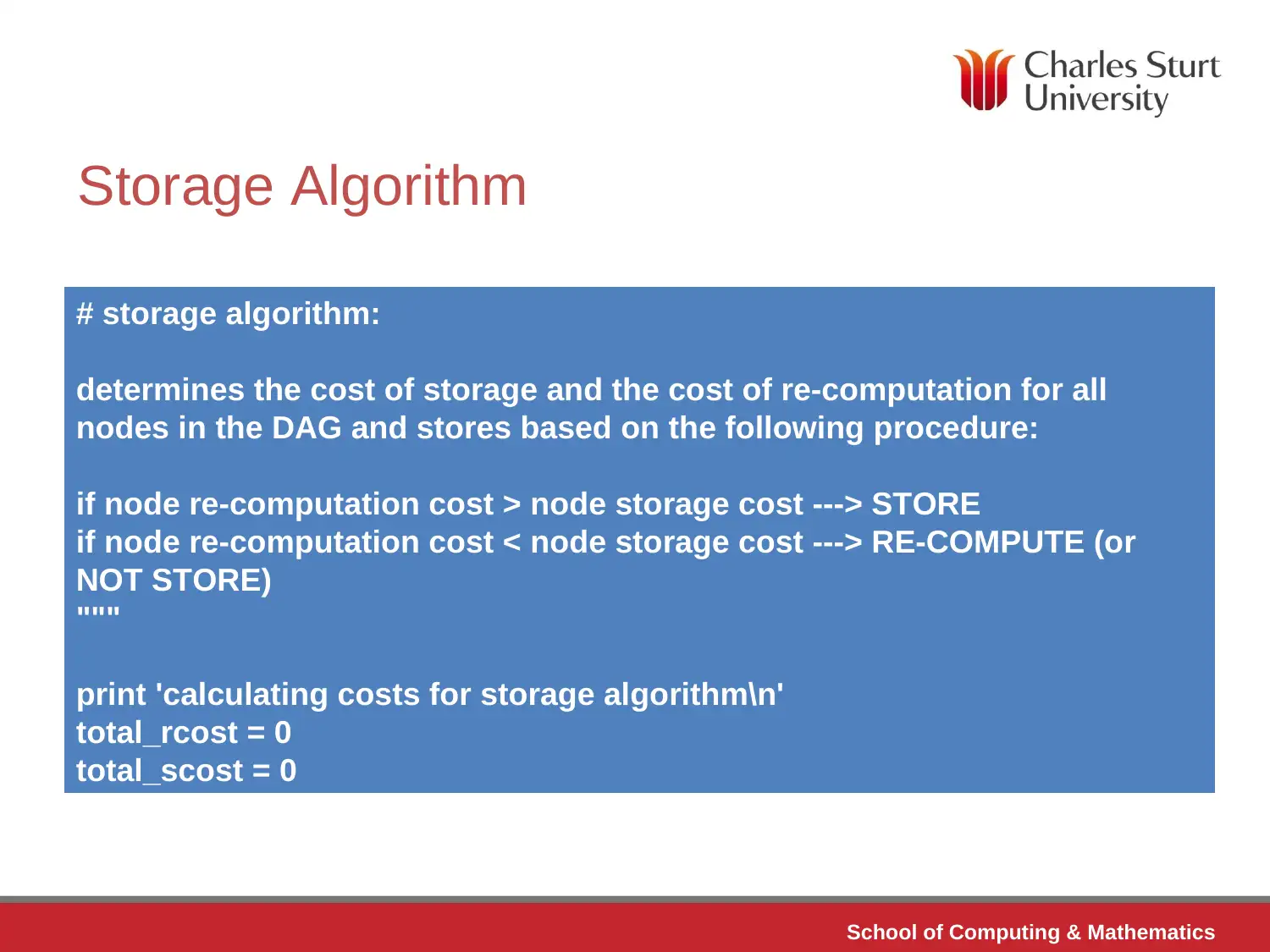
School of Computing & Mathematics
Storage Algorithm
# storage algorithm:
determines the cost of storage and the cost of re-computation for all
nodes in the DAG and stores based on the following procedure:
if node re-computation cost > node storage cost ---> STORE
if node re-computation cost < node storage cost ---> RE-COMPUTE (or
NOT STORE)
"""
print 'calculating costs for storage algorithm\n'
total_rcost = 0
total_scost = 0
Storage Algorithm
# storage algorithm:
determines the cost of storage and the cost of re-computation for all
nodes in the DAG and stores based on the following procedure:
if node re-computation cost > node storage cost ---> STORE
if node re-computation cost < node storage cost ---> RE-COMPUTE (or
NOT STORE)
"""
print 'calculating costs for storage algorithm\n'
total_rcost = 0
total_scost = 0
⊘ This is a preview!⊘
Do you want full access?
Subscribe today to unlock all pages.

Trusted by 1+ million students worldwide
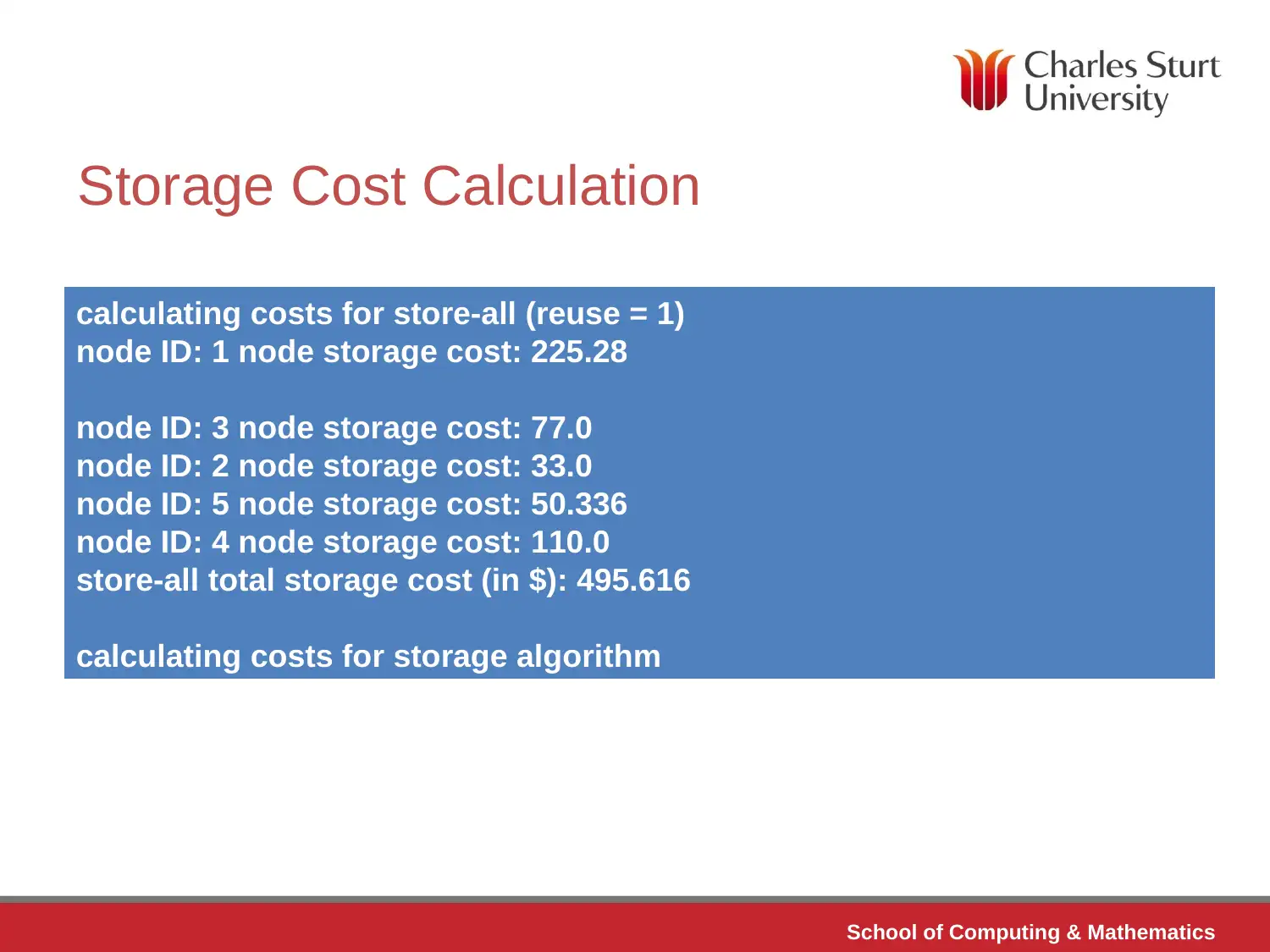
School of Computing & Mathematics
Storage Cost Calculation
calculating costs for store-all (reuse = 1)
node ID: 1 node storage cost: 225.28
node ID: 3 node storage cost: 77.0
node ID: 2 node storage cost: 33.0
node ID: 5 node storage cost: 50.336
node ID: 4 node storage cost: 110.0
store-all total storage cost (in $): 495.616
calculating costs for storage algorithm
Storage Cost Calculation
calculating costs for store-all (reuse = 1)
node ID: 1 node storage cost: 225.28
node ID: 3 node storage cost: 77.0
node ID: 2 node storage cost: 33.0
node ID: 5 node storage cost: 50.336
node ID: 4 node storage cost: 110.0
store-all total storage cost (in $): 495.616
calculating costs for storage algorithm
Paraphrase This Document
Need a fresh take? Get an instant paraphrase of this document with our AI Paraphraser
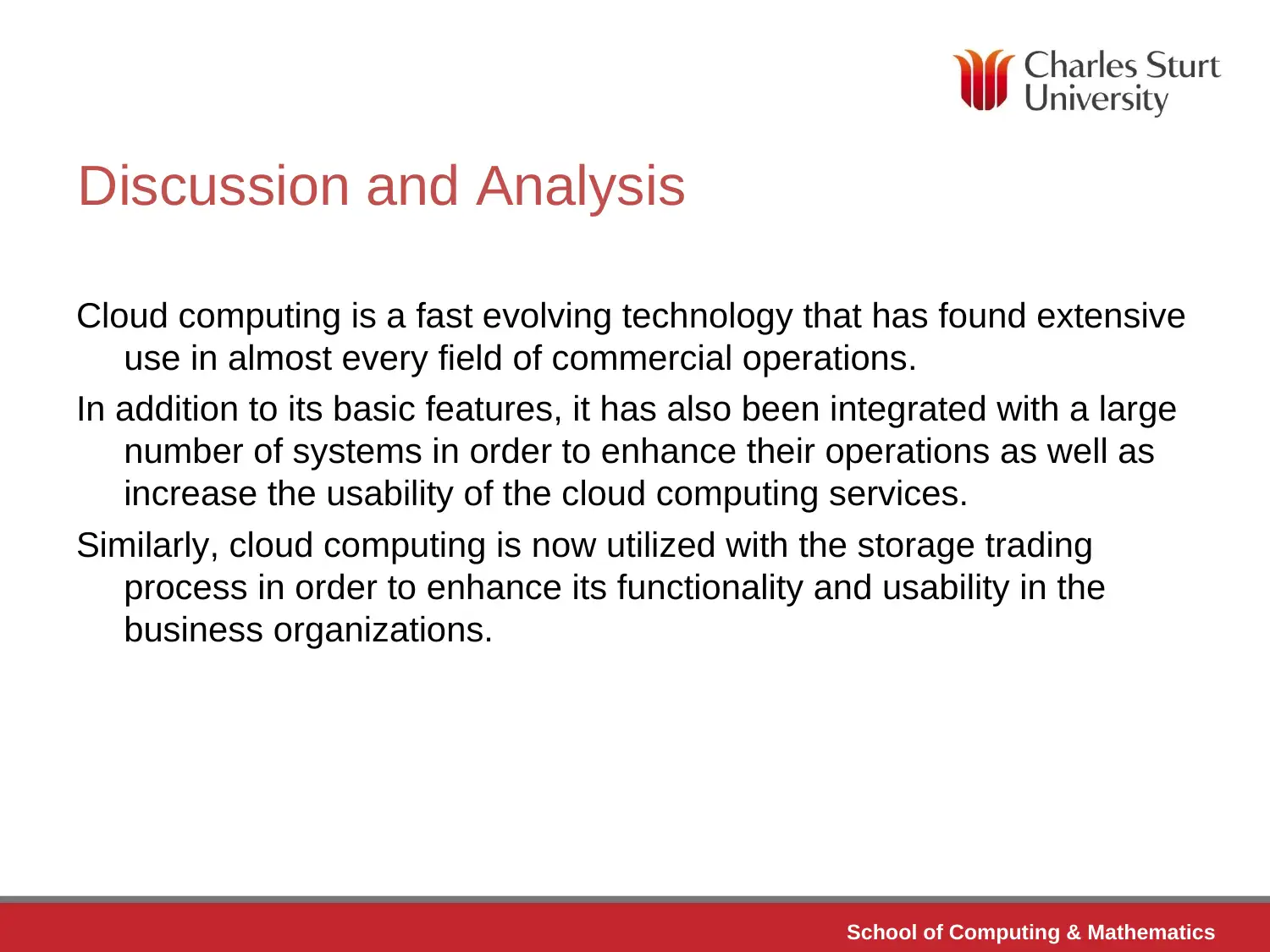
School of Computing & Mathematics
Discussion and Analysis
Cloud computing is a fast evolving technology that has found extensive
use in almost every field of commercial operations.
In addition to its basic features, it has also been integrated with a large
number of systems in order to enhance their operations as well as
increase the usability of the cloud computing services.
Similarly, cloud computing is now utilized with the storage trading
process in order to enhance its functionality and usability in the
business organizations.
Discussion and Analysis
Cloud computing is a fast evolving technology that has found extensive
use in almost every field of commercial operations.
In addition to its basic features, it has also been integrated with a large
number of systems in order to enhance their operations as well as
increase the usability of the cloud computing services.
Similarly, cloud computing is now utilized with the storage trading
process in order to enhance its functionality and usability in the
business organizations.
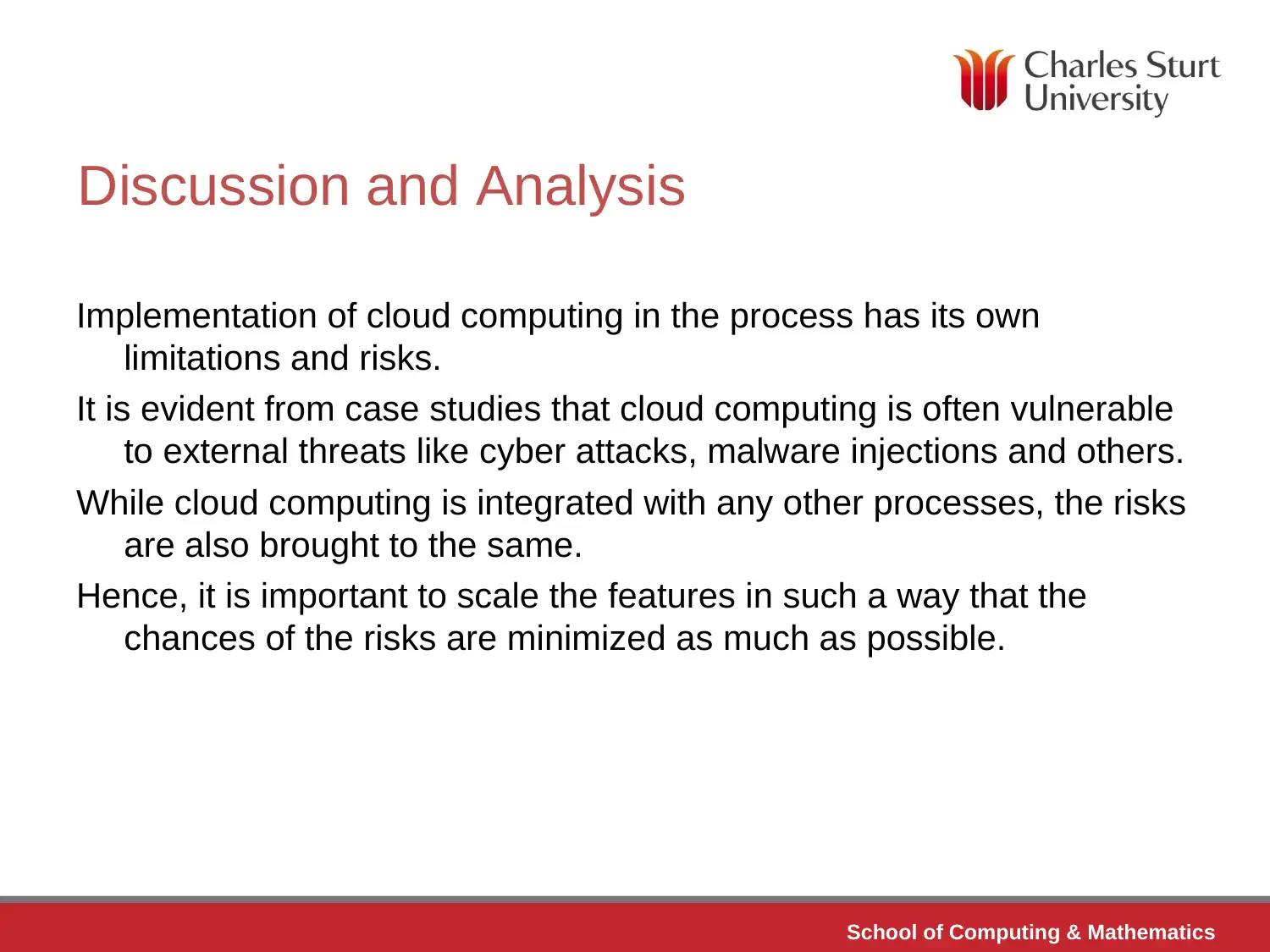
School of Computing & Mathematics
Discussion and Analysis
Implementation of cloud computing in the process has its own
limitations and risks.
It is evident from case studies that cloud computing is often vulnerable
to external threats like cyber attacks, malware injections and others.
While cloud computing is integrated with any other processes, the risks
are also brought to the same.
Hence, it is important to scale the features in such a way that the
chances of the risks are minimized as much as possible.
Discussion and Analysis
Implementation of cloud computing in the process has its own
limitations and risks.
It is evident from case studies that cloud computing is often vulnerable
to external threats like cyber attacks, malware injections and others.
While cloud computing is integrated with any other processes, the risks
are also brought to the same.
Hence, it is important to scale the features in such a way that the
chances of the risks are minimized as much as possible.
⊘ This is a preview!⊘
Do you want full access?
Subscribe today to unlock all pages.

Trusted by 1+ million students worldwide
1 out of 16
Related Documents
Your All-in-One AI-Powered Toolkit for Academic Success.
+13062052269
info@desklib.com
Available 24*7 on WhatsApp / Email
![[object Object]](/_next/static/media/star-bottom.7253800d.svg)
Unlock your academic potential
Copyright © 2020–2025 A2Z Services. All Rights Reserved. Developed and managed by ZUCOL.



